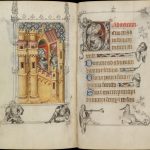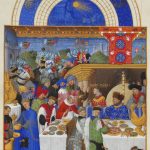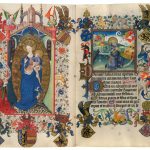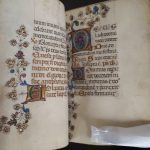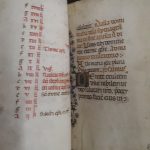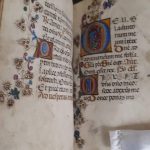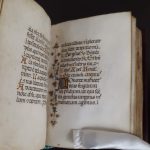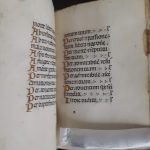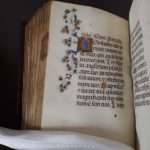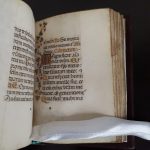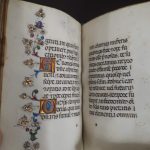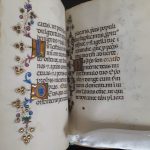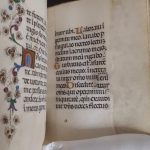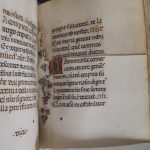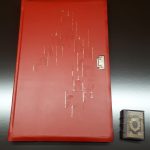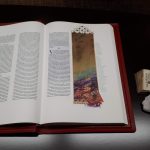The Bishop Farrell Library & Archives is fortunate to have two stunning illuminated manuscripts in our collections. The first manuscript we acquired is a Heritage Edition of The Saint John’s Bible, an item that we promote and use regularly in our outreach programming. Give us the chance and we will talk your ear off about The Saint John’s Bible! Our other illuminated manuscript is given much less fanfare – although it is likewise beautiful and spiritually edifying. Donated to the Library & Archives as a complement to The Saint John’s Bible, it is an Italian book of hours from the 15th century. Written in Latin with Italian rubrics, it is the core of a renaissance manuscript that unfortunately had many of its pages pillaged for the beautiful gold decorations. While this has surely impacted its value, it remains a charming example of a popular form of manuscript and lends a counterpoint to our other illuminated work of art.
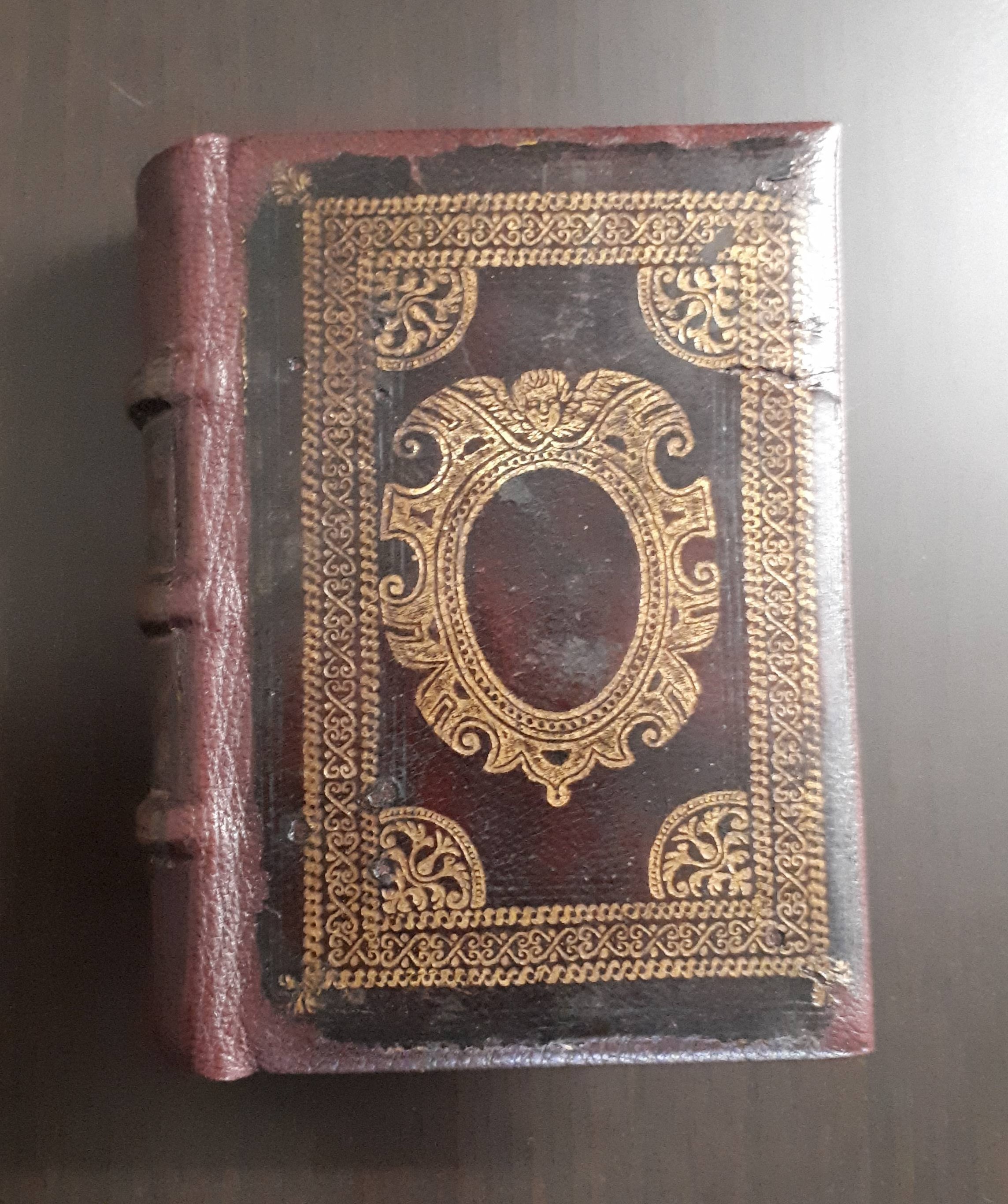
Book of Hours, ca. 1450 – 1500, Italy, (DHA.003.001)
Books produced before the advent of the European printing press in the late 15th century were by necessity handwritten and therefore known as manuscripts – “manus” meaning hand in Latin and “scriptum” meaning writing. These were ornamented with painted illustrations, decorated letters, calligraphic embellishments, and elaborate borders. Any of these elements could be “illuminated” – lit up with gold, silver, or brilliant colors. The illuminations could be used to express symbolic significance, represent holy figures, or elaborate the text. Elements chosen were done so with thought and importance, the more ornate illuminations demarcating text of particular substance. Illuminations added a visual commentary to guide the reader in their understanding of the text and its intended use. Early manuscripts were produced as scrolls on papyrus. By the end of the 1st century the use of animal skins, typically vellum the skin of a cow or parchment the skin of a sheep, were used in the book format that is common today. Illuminated manuscripts reached their height of popularity in the Middle Ages (ca. 500 to ca. 1500). The introduction of the printing press by Johannes Gutenberg in ca. 1455 slowed the production of handwritten texts, however illuminated manuscripts were still produced into the early 17th century.
- Hours of Jeanne d’Evreux, Image Credit: The Met Museum
- Très Riches Heures of duc de Berry, Image Credit: R.M.N. Photographic Agency
- The Hours of Catherine of Cleves, Image Credit: Faksimile Verlag Luzern
The creation of illuminated manuscripts was intensive and required the cooperation of many scribes labouring together to prepare the vellum, mix the inks, hand write the texts, and paint the images. Often these bookmakers were nuns and monks, working in monastery scriptoriums. The monasteries required books for their liturgical and spiritual needs, but they also worked to preserve classical literature and fill European libraries. By the late Middle Ages, the demands of laity for religious works increased and impacted the nature of the books being produced. The most popular type was the book of hours, a Christian devotional following the monastic set of prayers said throughout the day. In fact, according to art historian Wendy Stein, “from the fourteenth to the mid-sixteenth century, more books of hours were made than any other type of book” (http://www.metmuseum.org/toah/hd/hour/hd_hour.htm, 2017). A book of hours could take a variety of forms based on local traditions and the individual interests of the patron. However, the core of all variations is the Hours of the Virgin, a devotional sequence of prayers centred on the veneration of the Virgin Mary. Books of hours were commissioned by nobility and the wealthy merchant class. Personalization could include the addition of a calendar, gospel lessons, and prayers focusing on the Cross, or specific saints. Likewise, the illuminations could be chosen, from a few versals (painted initial letters) to full page art works, with a fee for each embellishment. The books were not inexpensive! The ability to customize these works and a shift in society towards personal piety, were both key factors in the popularity of books of hours. Famous examples include: the Hours of Jeanne d’Evreux, a book of hours (without gold) made in Paris for the Queen of France ca. 1324 – 28; Très Riches Heures of duc de Berry, a book of hours commissioned by Duke Jean I of Berry from the Limbourg brothers in the 15th century; and The Hours of Catherine of Cleves, a Dutch manuscript from ca. 1440 commissioned for the Duchess of Guelders.
- Page from our 15th century book of hours showing the fine embellishments
- Page from our 15th century book of hours showing part of the calendar
- Page from our 15th century book of hours showing part of the calendar
- Page from our 15th century book of hours showing the fine embellishments
- Page from our 15th century book of hours showing the fine embellishments
- Page from our 15th century book of hours showing versal letters written in gold
- Page from our 15th century book of hours showing the fine embellishments
- Page from our 15th century book of hours showing the fine embellishments
- Page from our 15th century book of hours showing the fine embellishments
- Page from our 15th century book of hours showing the fine embellishments
- Page from our 15th century book of hours showing an example of the damages incurred
- Page from our 15th century book of hours showing an example of the damages incurred
- Page from our 15th century book of hours showing an example of the damages incurred
The illuminated book of hours in our collection is a much less ornate version than those well-known counterparts. But it does include enchanting versal initials and leafy designs throughout in burnished gold and bright colours. The calligraphy is written on vellum in black ink, with a tight, neat hand. The pages of the book are ruled to allow for straight lines, as was common in illuminated manuscripts of the time. Customization to reflect local interests can be seen in the contents. The book comprises a calendar; the Hours of the Virgin with the Advent Office and other seasonal variants; the Mass of the Virgin; the Hours of the Cross; the Penitential Psalms and Litany; and the Office of the Dead. The calendar includes St. Nicholas of Tolentino and the Litany includes St. Bernardinus, and mentions St. Reparata of Florence and Sts. Regulus and Cerbonius, African martyrs in Tuscany. The mention of these saints connecting the book of hours to its Italian heritage. The manuscript is quite small at 5-inches by 4-inches. The size speaks to its intended use as a private devotional. It could be easily held and transported for daily use.
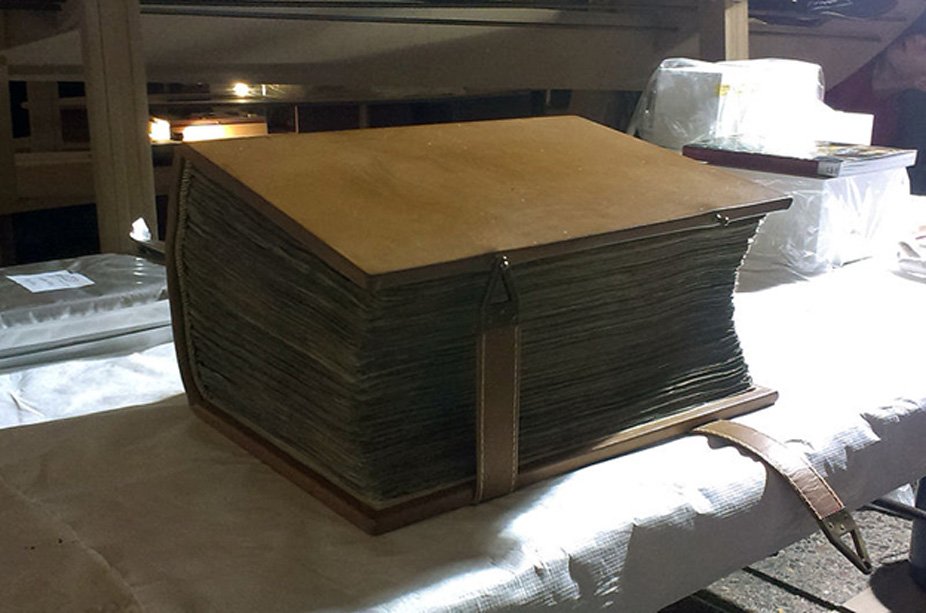
Codex Amiatinus, Image Credit: Remi Mathis/ CC BY SA 4.0
The prominent expert of medieval manuscripts Christopher de Hamel notes in his book Meeting with Remarkable Manuscripts that “manuscripts are not all the same size” (2016, p. 6), going on to explain that “throughout the Middle Ages there was a strong feeling for the hierarchy of things, both in the natural and the human worlds, often expressed by size” (ibid). de Hamel uses the gigantic Codex Amiatinus, the earliest complete Latin Bible made at Wearmouth-Jarrow in Northumbria in the early 8th century and the Hours of Jeanne d’Evreux to illustrate his point. The Codex Amiatinus is a whopping 1-foot-thick and was intended for public display. The minute Hours of Jeanne d’Evreux is similar in size to the book of hours in our collection at approximately 4-inches by 3-inches by 1-inch and was meant for the personal devotion of a queen.
- The large Saint John’s Bible is intended to inspire people gathered in community.
- The dainty book of hours was used for personal devotion.
In our case, our beautifully dainty book of hours comes in stark contrast to our massive edition of The Saint John’s Bible. The Saint John’s Bible is a modern day illuminated manuscript, designed and produced from 2000 – 2011. It is the full Catholic bible encompassing seven volumes: Pentateuch, Historical Books, Wisdom Books, Psalms, Prophets, Gospels and Acts, and Letters and Revelation. And it is large! The bulkiest volume, Historical Books, is 2.5-inches-thick and 1.5-feet by 2-feet in size. It weighs just under 20lbs! The Bishop Farrell Library & Archives maintains a Heritage Edition of the Bible. This is a fine art reproduction intended to be shared as widely as possible. Its size allows for people to gather around the pages to discover the art and explore the scripture together. The original version is on permanent display at St. John’s University & Abbey in Collegeville, Minnesota, the commissioning institution. The original Saint John’s Bible was hand-calligraphed and illuminated on vellum using inks from the 19th century, at the artistic direction of the renowned British calligrapher Donald Jackson. He worked with an international team of artists, calligraphers, and scholars, to bring to the world a 21st century illuminated manuscript in the same tradition as the highest quality of medieval manuscripts. It is the first handcrafted bible of its scale to be commissioned by a Benedictine abbey in over five hundred years. The fragile nature of the original necessitates its safekeeping behind glass. However, St. John’s University wanted a version of the Bible that could be circulated, touched, delved into in a tactile and intimate manner. This led to the creation of 299 Heritage Editions. Printed on 100% cotton paper the pages of the Heritage Edition were designed to look and feel like vellum. Each set is hand treated after printing, with gold stamped and embossed onto the pages to ensure they are true to the artistic intent of the original manuscript. The gold throughout The Saint John’s Bible is intended to symbolize the presence of the divine and it illuminates noteworthy scriptural passages. Themes of transformation, justice for God’s people, and hospitality are emphasized in text and imagery throughout The Saint’s John’s Bible. Similar to the book of hours in our collection, it is meant to provide edification, spiritual enlightenment, and inspiration. But rather than individual devotion it is meant to inspire community. The difference of intent is all in the size!
